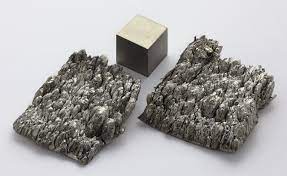Identity.
Scandium is a chemical element; it has symbol Sc and atomic number 21.
It is a silvery-white metallic d-block element. Historically, it has
been classified as a rare-earth element, together with yttrium and the
lanthanides.
Atomic Structure:
The nucleus consists of 21 protons (red) and 24 neutrons (blue). 21
electrons (green) bind to the nucleus, successively occupying
available electron shells (rings).
History.
Scandium, a silvery-white metal with surprising strength and
lightness, boasts a history intertwined with both chance and
scientific deduction. Its story begins in the late 19th century with
the Swedish chemist Lars Fredrik Nilson. While meticulously working
with rare-earth minerals, Nilson stumbled upon an unknown element
hidden within. Through careful analysis, he identified its unique
spectral signature, marking the official discovery of scandium in
1879.
Intriguingly, the existence of scandium wasn't entirely a
surprise. Just a decade earlier, the visionary chemist Dmitri
Mendeleev, guided by the periodic table's predictive power, had
postulated the existence of an element with properties eerily
similar to scandium. He even dubbed it "eka-boron," meaning "below
boron" in its place on the table. When Nilson's discovery came to
light, the scientific community marveled at the remarkable
alignment between prediction and reality, cementing the power of
the periodic table as a roadmap for exploring the unseen.
Usage.
Scandium is mainly used for research purposes. It has, however, great
potential because it has almost as low a density as aluminium and a
much higher melting point. An aluminium-scandium alloy has been used
in Russian MIG fighter planes, high-end bicycle frames and baseball
bats.
Scandium is used in aluminum-scandium alloys for aerospace industry
components and for sports equipment such as bicycle frames, fishing
rods, golf iron shafts and baseball bats. Scandium iodide is used in
mercury vapor lamps, which are used to replicate sunlight in studios
for the film and television industry.
Some of the benefits of using scandium are:
-
Scandium-aluminum alloys can help make airplanes lighter, which
improves fuel efficiency and range.
-
Scandium alloys could lead to longer-lasting and more powerful
batteries for electric vehicles and other devices.
-
Scandium-based materials could improve the efficiency and
durability of fuel cells, which are a clean and sustainable energy
source.
Sources.
Scandium, a silver-white metallic element, might be rare, but it pops
up in surprising places! It's found in trace amounts in many minerals,
but commercially, it's usually extracted as a byproduct from mining
other metals like titanium and uranium. While Madagascar and
Scandinavia boast rare minerals with concentrated scandium,
thortveitite being the champion, most comes from reprocessing waste
materials from other mining operations.
Properties.
Scandium, a silvery-white metal, boasts several unique properties that
set it apart. It's remarkably lightweight, yet exceptionally strong,
making it an attractive candidate for high-performance alloys used in
airplanes and even baseball bats. Scandium also readily conducts
electricity and heat, making it useful in some types of lighting and
potential future applications like fuel cells. But perhaps its most
interesting property is its rarity. Despite being the 23rd most
abundant element in Earth's crust, it's scattered in trace amounts,
making its extraction a fascinating scientific and engineering
challenge.

